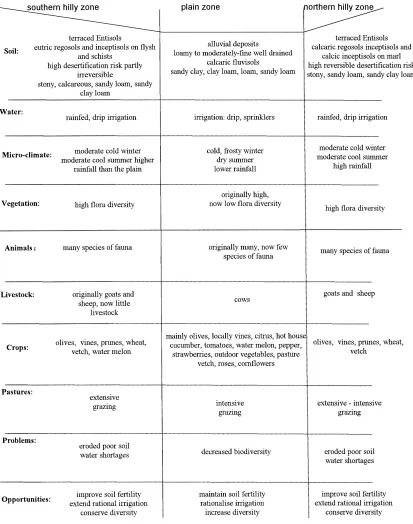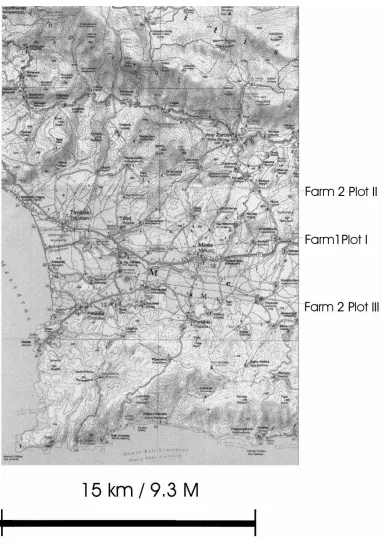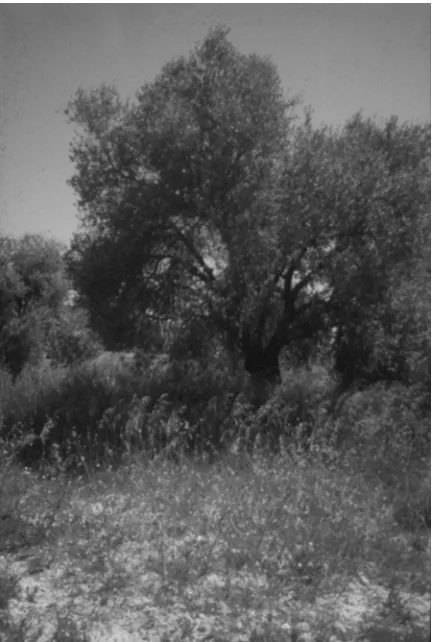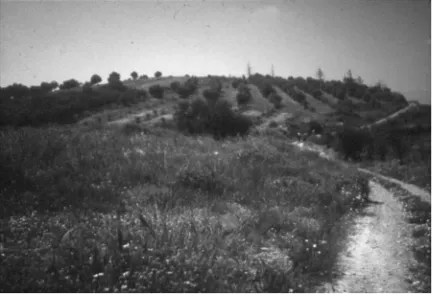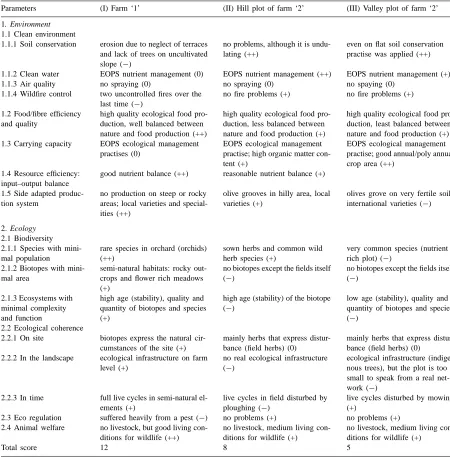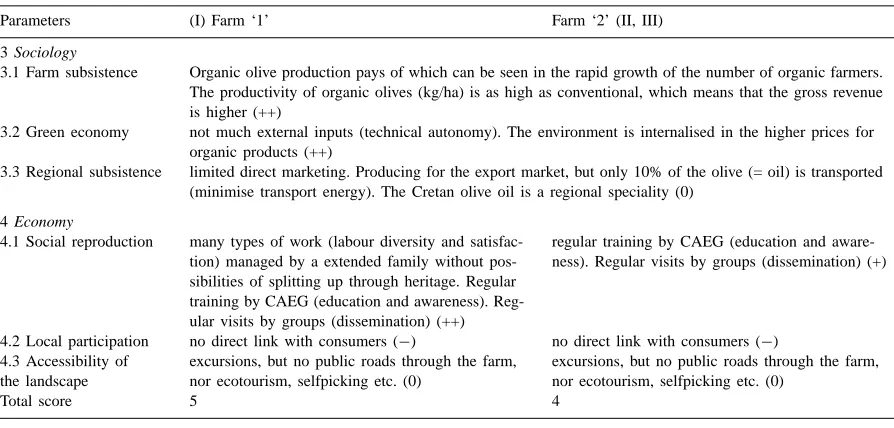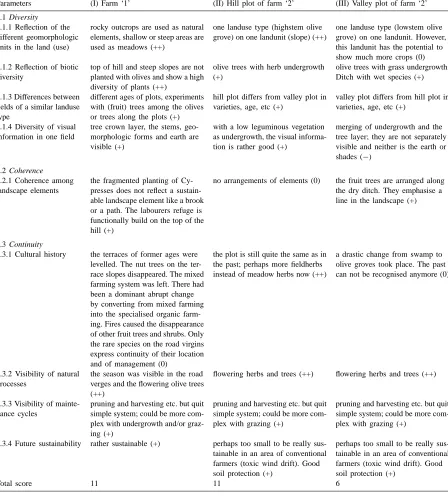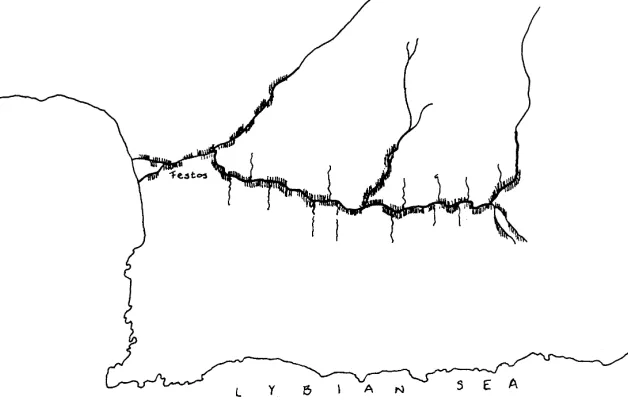Landscape quality on organic farms in the Messara valley, Crete
Organic farms as components in the landscape
Derk Jan Stobbelaar
a,∗, Juliëtte Kuiper
b, Jan Diek van Mansvelt
a, Emmanouil Kabourakis
caWageningen Agricultural University, Group Biological Farming Systems, Haarweg 333, 6709 RZ Wageningen, The Netherlands bWageningen Agricultural University, Group Landscape Architecture Haarweg 333, Wageningen, The Netherlands
cCretan Agri-environmental Group, Research and Development Unit, PO Box 59, 70400 Moires, Crete, Greece
Accepted 19 July 1999
Abstract
Two organic farms were evaluated on their landscape value in a broad perspective and compared with the surrounding non-organic farms. Therefore, a checklist with abiotic, social and cultural criteria was used. Firstly, an overview of the qualities of the Cretan landscape is given, which secondly, gives a framework to determine in how far the farms contribute to the landscape qualities. Thirdly, the scoring of the two described organic farms are compared with each other. This leads to the conclusion that the larger organic farm performs better than the smaller, especially concerning the abiotic environment. The cause of this difference in landscape performance may lie in the different social organisation of the two farms. However, when comparing the two farms with the (conventional) surrounding, both farms perform pretty well. ©2000 Elsevier Science B.V. All rights reserved.
Keywords: Checklist; Sustainability; Landscape quality: Organic agriculture; Crete
1. Introduction
This article reports on the use of the checklist en-titled: ‘Criteria for the development of sustainable ru-ral landscapes’ (from now on referred to as: check-list) (Van Mansvelt and Stobbelaar, 1997; Stobbelaar and van Mansvelt, 2000) in a specific European land-scape, on the island of Crete, Greece. The check-list is a condensation of key issues for the quality of a sustainable landscape. It combines many ideas on landscape (quality), of many landscape experts,
∗Corresponding author. Tel.: +31-317-484678; fax: +31-317-484995
E-mail address: [email protected] (D.J.
Stobbe-laar)
meeting in the framework of an EU AIR-3 Concerted Action (The landscape and nature production capac-ity of organic/sustainable types of agriculture AIR3 CT94-1296). The checklist has been developed in an iterative process of plenary and subgroup-meetings, during the last 4 years. New in this approach is the comprehensive and integrating concept, merging so called ‘hard’ and so called ‘soft’ criteria in one check-list. This new approach is needed to counteract the contraproductive effects of the EU regional measure-ments that focus on single-issue support. The checklist enables to evaluate the effect of measurements, like EU regulation 2078/92, which includes the stimulation of organic agriculture. The checklist should give general targets, although a local commitment on parameters for reaching these targets is needed. A quick
tion of farms in relation to the surrounding landscape, as described in this contribution, can only be done with the help of local experts (among others farmers). In this respect, a clear protocol on how to use the check-list by laymen is needed.
The objective of this paper is to evaluate current land use practises on the island of Crete and to give recommendations for the improvement of land use viz. landscape, both on practical farm level and for regional policy. In other words, to assess the practical use of the checklist. Note that the checklist can be used on several levels (e.g., farm level, regional level), accord-ing to the demands of the users (Stobbelaar and van Mansvelt, 2000).
2. Background and method
2.1. The landscape and agriculture in the Messara valley
2.1.1. Agriculture in the Messara valley
The Messara valley has a semiarid climate with an average annual precipitation of approximately 600 mm and an average precipitation around 1700 mm. Aver-age monthly temperature varies between a maximum
of about 25◦C in July and August and a minimum of
about 10◦C in January and February.
Two main agro-ecological zones occur in the Mes-sara region, the hilly zone, surrounding the plain, and the plain (Fig. 1). These zones have got different agro-ecological characteristics (Kabourakis, 1996).
The Messara valley is an alluvial plain mainly com-posed of quartenary deposits, in the north bordered by a hilly area of silty-marley neogee, and bordered by schist and limestone formations in the south. The soils in the plain belong to the order of Entisols.
The Messara landscape has been in cultivation since thousands of years (Fig. 2). The marshes of the Mes-sara valley however were taken into cultivation only 20 years ago. There is no forest left in the region. About 30% of the flora of Crete is linked to agriculture and around 200 species are imported with agricultural systems from abroad.
Traditional farming systems were mixed systems; the average farmer had olive groves, a vineyard, a horticultural field (garden), arable fields, which were
also used for grazing, and animals. This very much suited the labour-film: olive growing demands labour mainly in wintertime, while in vine growing labour is needed in spring and summertime. Besides, horticul-tural crops require labour in spring or autumn. Ani-mals were grazing in the fields and in the olive groves, and were used for transportation and land cultivation. Nowadays Cretain farming systems are specialised monocultures, with olive groves both in the hills and in the plain. Vine growing is loosing importance, as it is labour intensive and because of the low prices achieved by vine products. Still vines remain in limited areas. Some parts, both in the hills and in the valley, are used for horticulture under plastic.
Olive oil is the main product of the island and at the moment the most profitable crop of the farmers. Vegetables need fast transport to the market, which is not always possible from an island. Excellent wines and raisins are produced on the island, but due to harsh competition in the world markets, problems of management and marketing, and the problems of grape phyloxera in the 70s and 80s the production was not too high. In contrast to fresh products, olive oil does not need fast transport, but its price is also under pressure on the saturated European market, while marketing problems have started to appear. This single-commodity approach makes olive grow-ers vulnerable to market fluctuations. This counts for both ecological farmers and conventional farmers, although the ecological market is not so hectic yet.
In Crete, the farmhouses are usually concentrated in the villages. The fields of the farmers are scattered around these villages. In Messara, the average farmer has about 5–10 plots. The average distance from the house to the plots is 3–5 km. This uneconomic situ-ation partly exists due to the Cretan heritage system, where all children receive a part of the farm, and the unwillingness to exchange fields among farmers, due to the difference in fertility of the fields.
2.1.2. Landscape quality at regional and local level
the farming system) to contribute to the aesthetic and ecological qualities. It should be possible for people to orientate themselves in space and time.
The Messara landscape contains outstanding land-scape elements like the snowy hills (Ida mountain) and the archaeological site of Phaistos. These elements form the framework of the landscape and certainly add to the possibility to orientate in space and time. Also in the hills some landmarks can be found (typical hill-tops or views), this in contrast to the plain. Within the large plain, covered with young olive yards, the main brooks and minor ditches are not visible from a dis-tance and hardly distinguishable at all. Also, the main roads cannot be distinguished from minor roads. This means that the coherence or order between landscape components is hardly legible. If some wet sites had been conserved it would have been better for the legi-bility of the landscape and the biodiversity. The change in time from marshland to olive production area was very abrupt.
In the hills, the changes in the landscape have been more gradual. Nevertheless, the levelling of many ter-races decreased the natural elements and had a dis-astrous effect on the cultural heritage and visual as-pects of the Messara valley. Some of the old high stem olive groves have been converted into low stem ones. The sustainability of the olive groves on steep slopes, with bare land underneath, is endangered by erosion of the fertile topsoil and the monoculture of olive groves is vulnerable to pest and diseases and to economic changes in the oil world markets. In the eyes of the Eu-ropean landscape experts the landscape looked worn out.
The differences of soil quality between the hills and the plain are no longer reflected in the land use and therefore neither in the landscape. The wider variety of crops that is possible in the plain is not exploited; the long-term investment of the olive production makes it difficult to follow the market, if necessary. Landscape diversity is therefore less than it could be. Also nowa-days landscape elements like forest, old trees and wet situations or water surfaces are missing in the western part of Messara.
2.1.3. Landscape quality at farm level
On the visited organic olive farms different types of management were distinguished:
Fig. 3. High stem olive grove with short grass and herb vegetation as undergrowth. There is a clear distinction between the grass layer and the tree layer.
1. A short sheep grazed vegetation below high stem trees (Fig. 3);
2. Ploughed land below high or low stem trees; 3. High spontaneous herb vegetation of different
species below high or low stem trees;
4. Seeded cover crops in high stem groves (Fig. 4) and in low stem groves (Fig. 5).
These different kinds of management effect erosion, species richness, social life and visual experiences.
The traditional way of combining high stem olive trees and husbandry (type 1), which have the best ef-fects for the checklist criteria soil quality, biodiver-sity, visual experiences tends to vanish. The farmers are very content not to have the continuous care for the grazing animals anymore. Mixed farming systems are more demanding in labour and management skills, while the current structure of the agricultural sector does not favour them. Besides, the social life of farm-ers improved by applying less labour demanding tech-niques.
Fig. 4. High stem olive grove with herb layer as undergrowth at farm ‘2’.
2.2. Cretan landscape policy
Cretan landscape policy does not really function. This is mainly due to the absence of interest. Next to this other reasons are a lack of knowledge and the large number of organisations (Development agencies) and state services responsible for management of en-vironment and landscape, without much co-ordination (Region of Crete, Forest service, Agricultural service, Water resources development service, National tourist organisation, Archaeological service, Service for the environment, Spatial planning and Public works). Be-sides, all these organisations do not have common pol-icy but even contradictory policies aiming on the one hand, to the development of the island through ex-ploitation of its resources, and on the other hand, to the protection and conservation of these resources.
Fig. 5. Low stem olive grove with (high) grasses as undergrowth at farm ‘2’. There is no clear distinction between the grass layer and the tree layer.
2.3. Assessment procedure
In the assessment procedure, the knowledge and expertise of European (landscape) experts were com-bined with that of local expertise’s key persons. Here, the ‘Cretan agro-environmental group’ (CAEG) and the members of the EU-network, visited some ran-domly selected farms in the Messara region, from 4 to 8 May 1997. They were asked to apply the checklist, comparing the strong and weak points in the ‘sustain-able landscape production’ of these farms with those of the surrounding region.
Key questions were:
How does the farm contribute to the (landscape) qual-ity of the region?
How does the farm solve regional land-scape viz. land-use problems?
To answer these questions, information on both the farms and the region was needed. The landscape ex-perts observed the farm and its surrounding, follow-ing the checklist. The local experts provided the group with additional information.
targets like those of the checklist are indispensable to set the locally relevant quantitative targets, in a con-sistent, inter-regionally compatible way (e.g., Rossi et al., 1997).
The first farm and the two plots of the second farm are compared within the framework of the checklist. For an extensive explanation of the criteria and param-eters used in this checklist, see Van Mansvelt and van der Lubbe (1998) and Stobbelaar and van Mansvelt (2000). The numbers in the tables and lists refer to the mentioned checklist. The idea is to find the strong and weak points of the farms, related to the surround-ing landscape, in order to value the farms and to have a starting point for giving recommendations. An overview of the results is given in the concluding para-graph. Counting is done as follows:−, 0, +, ++, from low quality to high quality.
The information on the abiotic and cultural envi-ronment is gathered during the fieldtrips. The shown socio-economic information was abstracted from the farmers and Cretan agri-environmental group. Part 5 of the checklist (Psychology) is mainly used to struc-ture the (subjective) observations and thoughts of the users of the checklist. This part describes the subjec-tive appreciation of the farm and the landscape it be-longs to. It is used to become aware of the landscape qualities. This is the reason that we show the results of part 5 only in the text, and that we use the results of part 6, which is the ‘objective’ quality of the cultural realm, for the valuation. The three criteria used here, diversity, coherence and continuity are interrelated and inseparable (Kuiper, 1997, 1998). Main questions are: does the arrangement of the landscape components express the natural and cultural heritage and present meaning? Can people orientate themselves in space and time?
2.4. Cretan agri-environmental group and research on ecological olive production systems
Members of the Cretan agri-environmental group (CAEG) managed the two researched farms. CAEG was established in 1993 in the Messara plain (Fig. 2), at the beginning of the innovative research project for prototyping Ecological Olive Production Systems (EOPS) (Kabourakis, 1996). The main objective of the EOPS research was to design, test, improve and
disseminate prototypes of ecological olive production. Within this objective it was attempted to improve:
1. sustainability and stability of olive production and 2. growers’ perspectives and regional development.
Since 1993, the CAEG has been fast growing in participants and expertise. Its farmer’s members (or-ganic farmers of Messara) have accumulated experi-ences both in organic olive cultivation and processing techniques and in marketing of the organic olive prod-ucts. Extension is done by showing visitors around on the farms.
Comparing the approach of the EOPS research and the concerted action reported on, it was found that the EOPS research used a quite similar system wherein the member farmers prioritised their aims for sustainable olive production and development of the area, within the standards of Organic Agriculture (IFOAM, 1996). This can be seen as a mixed top down/bottom up/top down approach, in that, given the organic standards (top down) the aims of the members were collected (bottom up), and translated into appropriate objectives for the ecological production by the researchers (top down). The objectives of EOPS where then quantified by appropriate indicators (parameters). Farmers meet these objectives by using ecological farming methods. The research is done in co-operation with a pilot group of farmers, and with the contribution of the rest of the organic farmers in Messara.
All farmer members of the CAEG are regularly being trained through study/discussion meetings.
2.5. The farms
2.5.1. Farm ‘1’
Fig. 6. Flower rich meadow at farm ‘1’. This meadow is part of the ecological infrastructure of farm ‘1’.
Now two families live from the farm and also a next generation (coming up) may live from the farm.
The farm has some rocky outcrops and flowers rich meadows (Fig. 6) that serve as part of an ecological in-frastructure (Vereijken et al., 1995). Other more natu-ral parts are meadows on the steeper parts, the cliff and the (rows of) trees planted through the olive groves. One of the rows of Cypresses is a former boundary of the farm, which says something about the admin-istrative history of the farm, but has no real connec-tion with the natural underground, so it does not show (vertical) landscape coherence. The scattered planting of a few fruit trees between the olive yards did not re-sult in a distinctive landscape element that reflects the natural or cultural history (see Kuiper, 2000).
2.5.2. Farm ‘2’
Farm ‘2’ has 11 ha of land. It is scattered through the area (Fig. 1). The research group has visited two parcels of this farm, one situated in the hills with high stem olive trees (Fig. 4, from now on called plot II), one situated in the planes, with low stem trees (Fig. 5, from now on called plot III). Plot II consists of only one landscape element, namely the grove with herbs in the undergrowth. Plot III consists of the grove, a ditch and a surrounding row of native fruit trees and shrubs. The natural grasses and herbs in the under-growth were already mown when we visited the plot. They were not so colourful as the herbs in the moun-tains, probably owing to a much more fertile soil in the floodplain. The herbs and trees were introduced by the organic farmers in accordance the ecological
in-frastructure management method (Kabourakis, 1996). They can function as ecological reservoirs for preda-tors, to preserve the soil and to improve the ecological quality of the area.
3. Results
3.1. The quality of the abiotic environment
In Table 1 an overview is given of the scores on the abiotic realm of the three plots. On all three plots the ecological olive production system (Kabourakis, 1996) is being used. As described in Section 2.1, the agricultural landscape of Crete has become more and more monotonous over the past decades. The ecologi-cal olive production system tries to stop this trend. Although, the environmental situation of plot II and III is a little better than on plot I, this is not elaborated in the ecology of the farm. This might be a management effect, but is certainly a result of the larger surface reserved for semi-natural elements on plot I.
3.2. The quality of the social environment
The hill plot and valley plot are part of one economic unit, and because of that treated together here.
3.2.1. Economic factors
The organic farmers on the island may make good profit from their work. The number of farmers mem-bers of organic farmers of Messara — is increasing, as a sign that conventional production faces increas-ing agronomic problems while organic olive produc-tion pays off. However, this is mainly due to the suc-cess of the EOPS project initially at agronomic level, and later at management and economic level. Other important factors are the increasing problems of con-ventional production, and the increased awareness of the farmers of the effect of conventional farming on health and environment.
addi-Table 1
Abiotic scoring of the researched plots
Parameters (I) Farm ‘1’ (II) Hill plot of farm ‘2’ (III) Valley plot of farm ‘2’
1. Environment 1.1 Clean environment
1.1.1 Soil conservation erosion due to neglect of terraces and lack of trees on uncultivated slope (−)
no problems, although it is undu-lating (++)
even on flat soil conservation practise was applied (++)
1.1.2 Clean water EOPS nutrient management (0) EOPS nutrient management (++) EOPS nutrient management (+) 1.1.3 Air quality no spraying (0) no spraying (0) no spaying (0)
1.1.4 Wildfire control two uncontrolled fires over the last time (−)
no fire problems (+) no fire problems (+)
1.2 Food/fibre efficiency and quality
high quality ecological food pro-duction, well balanced between nature and food production (++)
high quality ecological food pro-duction, less balanced between nature and food production (+)
high quality ecological food pro-duction, least balanced between nature and food production (+) 1.3 Carrying capacity EOPS ecological management
practises (0)
EOPS ecological management practise; high organic matter con-tent (+)
EOPS ecological management practise; good annual/poly annual crop area (++)
1.4 Resource efficiency: input–output balance
good nutrient balance (++) reasonable nutrient balance (+)
1.5 Side adapted produc-tion system
no production on steep or rocky areas; local varieties and special-ities (++)
olive grooves in hilly area, local varieties (+)
olives grove on very fertile soil, international varieties (−)
2. Ecology 2.1 Biodiversity 2.1.1 Species with mini-mal population
rare species in orchard (orchids) (++)
sown herbs and common wild herb species (+)
very common species (nutrient rich plot) (−)
2.1.2 Biotopes with mini-mal area
semi-natural habitats: rocky out-crops and flower rich meadows (+)
no biotopes except the fields itself (−)
no biotopes except the fields itself (−)
2.1.3 Ecosystems with minimal complexity and function
high age (stability), quality and quantity of biotopes and species (+)
high age (stability) of the biotope (−)
low age (stability), quality and quantity of biotopes and species (−)
2.2 Ecological coherence
2.2.1 On site biotopes express the natural cir-cumstances of the site (+)
mainly herbs that express distur-bance (field herbs) (0)
mainly herbs that express distur-bance (field herbs) (0)
2.2.2 In the landscape ecological infrastructure on farm level (+)
no real ecological infrastructure (−)
ecological infrastructure (indige-nous trees), but the plot is too small to speak from a real net-work (−)
2.2.3 In time full live cycles in semi-natural el-ements (+)
live cycles in field disturbed by ploughing (−)
live cycles disturbed by mowing (+)
2.3 Eco regulation suffered heavily from a pest (−) no problems (+) no problems (+) 2.4 Animal welfare no livestock, but good living
con-ditions for wildlife (++)
no livestock, medium living con-ditions for wildlife (+)
no livestock, medium living con-ditions for wildlife (+)
Total score 12 8 5
tional labour that ecological olive production requires (Vassiliou, 1999).
Both farms are not heavily depending on external inputs. Farmers are purchasing the required manure for fertilisation from the area. Legumes in the un-dergrowth provide the most required nitrogen. Some-times, seeds for the cover crops are bought. The main
external input to the agro-ecosystem is traps for the olive fly protection.
Table 2
Social scoring of the researched farms
Parameters (I) Farm ‘1’ Farm ‘2’ (II, III)
3 Sociology
3.1 Farm subsistence Organic olive production pays of which can be seen in the rapid growth of the number of organic farmers. The productivity of organic olives (kg/ha) is as high as conventional, which means that the gross revenue is higher (++)
3.2 Green economy not much external inputs (technical autonomy). The environment is internalised in the higher prices for organic products (++)
3.3 Regional subsistence limited direct marketing. Producing for the export market, but only 10% of the olive (= oil) is transported (minimise transport energy). The Cretan olive oil is a regional speciality (0)
4 Economy
4.1 Social reproduction many types of work (labour diversity and satisfac-tion) managed by a extended family without pos-sibilities of splitting up through heritage. Regular training by CAEG (education and awareness). Reg-ular visits by groups (dissemination) (++)
regular training by CAEG (education and aware-ness). Regular visits by groups (dissemination) (+)
4.2 Local participation no direct link with consumers (−) no direct link with consumers (−) 4.3 Accessibility of
the landscape
excursions, but no public roads through the farm, nor ecotourism, selfpicking etc. (0)
excursions, but no public roads through the farm, nor ecotourism, selfpicking etc. (0)
Total score 5 4
Because the oil is mainly not sold on the local mar-ket the energy used for transport is quite high. On the other hand, only the end product (oil) is transported, which is less than 10% of the olive’s weight.
Olive oil is, in general, a speciality of the Mediter-ranean area. However, Cretan olive oil is of high qual-ity (90% of the olive oil produced in Crete has the highest quality: extra virgin). Next to this, olive oil of the area has specific organoleptic characteristics, e.g. aroma and taste. Cretan olive oil characteristics are since antiquity appreciated by consumers all over the world. Olive oil produced by organic farmers of Mes-sara is appreciated abroad as a speciality product of the area.
3.2.2. Social factors
Organic farming provides more types of work, be-cause of a more diversified farming system. This work, although it often is more and heavier work, could sup-ply more satisfaction to the farmer and in that way could contribute to keeping the land populated. Per-haps even more important is the fact that more labour per hectare is needed in organic agriculture. This also might keep the land populated. Note that ecological olive production does overall not require more labour inputs than the conventional intensive olive
produc-tion (Vassiliou, 1999). The large farm (I) is special in this respect. The farm is owned by an extended family, instead of a small household. The farm will not be split up by partible inheritance. This gives a solid base for sustainable land use in the sense of long lasting management by providing the possibilities (space) to make a real effort for ecological network-ing. This on its turn is an important basis for labour satisfaction.
There is no direct link to consumers that would like to participate either financially or physically to main-tain the farms. This is to a large extend due to the fact that the group has recently been established (dur-ing 1994), and partly due to the fact that there is no tradition, as there is in the Northern European coun-tries with e.g. ‘community based agriculture’. There happen to be some excursions (for farmers and re-tailers) to the farms, but there are no public roads through the farms, nor ecotourism, self-picking, etc.; there is no real direct contact of visitors with the land, which can establish an emotional bond with the place.
Table 3
Cultural scoring of the researched plots
Parameters (I) Farm ‘1’ (II) Hill plot of farm ‘2’ (III) Valley plot of farm ‘2’
6.1 Diversity 6.1.1 Reflection of the different geomorphologic units in the land (use)
rocky outcrops are used as natural elements, shallow or steep areas are used as meadows (++)
one landuse type (highstem olive grove) on one landunit (slope) (++)
one landuse type (lowstem olive grove) on one landunit. However, this landunit has the potential to show much more crops (0) 6.1.2 Reflection of biotic
diversity
top of hill and steep slopes are not planted with olives and show a high diversity of plants (++)
olive trees with herb undergrowth (+)
olive trees with grass undergrowth. Ditch with wet species (+)
6.1.3 Differences between fields of a similar landuse type
different ages of plots, experiments with (fruit) trees among the olives or trees along the plots (+)
hill plot differs from valley plot in varieties, age, etc (+)
valley plot differs from hill plot in varieties, age, etc (+)
6.1.4 Diversity of visual information in one field
tree crown layer, the stems, geo-morphologic forms and earth are visible (+)
with a low leguminous vegetation as undergrowth, the visual informa-tion is rather good (+)
merging of undergrowth and the tree layer; they are not separately visible and neither is the earth or shades (−)
6.2 Coherence 6.2.1 Coherence among landscape elements
the fragmented planting of Cy-presses does not reflect a sustain-able landscape element like a brook or a path. The labourers refuge is functionally build on the top of the hill (+)
no arrangements of elements (0) the fruit trees are arranged along the dry ditch. They emphasise a line in the landscape (+)
6.3 Continuity
6.3.1 Cultural history the terraces of former ages were levelled. The nut trees on the ter-race slopes disappeared. The mixed farming system was left. There had been a dominant abrupt change by converting from mixed farming into the specialised organic farm-ing. Fires caused the disappearance of other fruit trees and shrubs. Only the rare species on the road virgins express continuity of their location and of management (0)
the plot is still quite the same as in the past; perhaps more fieldherbs instead of meadow herbs now (++)
a drastic change from swamp to olive groves took place. The past can not be recognised anymore (0)
6.3.2 Visibility of natural processes
the season was visible in the road verges and the flowering olive trees (++)
flowering herbs and trees (++) flowering herbs and trees (++)
6.3.3 Visibility of mainte-nance cycles
pruning and harvesting etc. but quit simple system; could be more com-plex with undergrowth and/or graz-ing (+)
pruning and harvesting etc. but quit simple system; could be more com-plex with grazing (+)
pruning and harvesting etc. but quit simple system; could be more com-plex with grazing (+)
6.3.4 Future sustainability rather sustainable (+) perhaps too small to be really sus-tainable in an area of conventional farmers (toxic wind drift). Good soil protection (+)
perhaps too small to be really sus-tainable in an area of conventional farmers (toxic wind drift). Good soil protection (+)
Total score 11 11 6
consumers pay for green agriculture. The large farm is more progressive in the way it is socially organised, run by an extended family as a whole and not divided among the hears.
3.3. The quality of the cultural environment
cul-tural parameters Table 3. This is partly related to the fact that the plots are situated in different parts of the landscape. Their landscape appearance is subsequently also different. Nevertheless, plot III lacks behind in the scoring because of its abrupt changes in the land-scape history and the weak reflection of the potential landscape diversity. In contrast, plot I has the highest score because of a high landscape diversity (on several levels).
4. Discussion
4.1. Discussion of the results of the farm comparison
In Table 4 an overview of the scores on the sets of parameters is given. An overall score is added by counting up the separate scores. The scoring of the hill plot and valley plot on sociology is taken together, because the assessment was based on the performance of the whole farm.
Both farms contribute to the landscape quality of the region, the large farm (I) even more than the scattered farm (II, III). The scattered farm performs better on environmental issues, but this is not translated in a high score on ecological qualities. On the contrary, the main difference between the farms is that the larger farm scores much better on ecological qualities. The lower score on ecological parameters of the scattered farm is due to the small size of the plots. This can not be changed easily, whereas the improvement of environmental qualities of farms, which is a task for the larger farm, is (just) a matter of changing farming style. Especially conserving the soil by undersowing grasses and herbs, and by planting trees on steep slopes would help a lot (e.g. against erosion).
Both farms do score reasonably well on the socio-logical realm. This is largely due to the fact that the farmers work according to the standards for organic farming. The scoring on cultural parameters is good for both farms, although is must be mentioned that the difference between the large farm (I) and the val-ley plot (III) is still rather large. This difference can mainly be explained out of the fact that the scoring of the large farm (I) is absolutely very high. Another factor is that, in our opinion, the land use of the val-ley plot (III) is not the most wanted for the legibility of the landscape.
Note that the scores of the scattered farm on ecology and the larger farm on environment are only relatively bad: the ecological farms in general are much ahead of the average Cretan olive farm, where e.g. soil, flora and fauna erosion are severe problems (Kabourakis, 1996). It could be argued that the larger farm its higher landscape and ecological score is indebted to its social organisation. By keeping the land as a unit through the generations of farmers a more stable management can be reached on a larger surface.
4.2. Solving the Cretan landscape problems
The Island of Crete is (still) famous for its land-scape and nature. In the Messara valley the surround-ing hills and mountains and elements such as Phestos ruins are strong landmarks that make the framework of the landscape. The shoulders of the roads in the area are flowering of numerous herb species and the Garigue is interesting for its landscape both as its nat-ural values. Although the natnat-ural situation of the is-land is unclear yet (Rackham and Moody, 1996), one could easily state that the Messara landscape expresses itself mainly through agricultural use. Owing mainly to olive oil prices and competition problems in the in-ternational markets, this landscape image has become rather monotonous, with olive groves everywhere. The legibility of the Messara landscape is low. The differ-ent geomorphologic and abiotic units are not reflected anymore in the land use nor in the natural vegeta-tion. By regularly ploughing and spraying on the olive plots, the vegetation cover has been reduced to almost nothing. This also causes erosion problems.
Table 4
Total score of the two researched farmsa
Total score Environment Ecology Sociology Culture Total
I Large farm 4 (25) 8 (50) 5 (42) 11 (61) 28 (45)
II Hill plot 9 (56) −1 (0) 4 (33) 11 (61) 19 (30)
III Valley plot 6 (37) −1 (0) 7 (38) 12 (19)
maximum: 16 maximum: 16 maximum: 12 maximum: 18 maximum: 62
aThe values in the parentheses are given in % score.
solving regional (landscape) problems, but that a real solution needs a large step forward both in policy sup-porting landscape development and organic farming, and in the growth of the amount of organic farmers.
4.3. Discussion on the method
The method applied can be characterised as some sort of ‘rapid rural appraisal’: (only) a first impression of qualities and problems, in the eyes of a group of experts is given. However, this visit can hopefully im-ply a renewed start for local discussion, both within the organic agricultural movement as between farmers and politicians/local inhabitants.
4.4. The role of the Cretan agri-environmental group
The history of CAEG taught us about the impor-tance of social structures in progressive movements: social structures give the possibility to learn from each other, to reach political goals, to set common (ecolog-ical) goals, and to promote products ( e.g. on interna-tional exhibitions).
4.5. Recommendations to improve the landscape quality of the Messara valley, Crete
4.5.1. Landscape on regional and local level
• Create an ecological network, which fits into the
landscape structure and underlines the identity of the landscape types (Fig. 7). The ecological network should be a guide for farmers in telling them for which ecosystem and species their farm is impor-tant and how they can contribute to the landscape quality. Initiate the implementation of the ecolog-ical network in those landscape units that already have the highest landscape quality.
• Emphasise in the Messara valley the difference be-tween the plains and the hills. The difference in fertility and possibilities for land use should be
ex-ploited. The land use of the plains should reflect the fertility and potentials for many different kinds of land use and should be able to follow the market. The olive yards on the hills should reflect the diffi-cult circumstances and the rationality of a long-term investment.
• Initiate sustainable planting, adjacent to still ex-isting natural elements (woods). This planting can consist of linear elements aligning important land-scape elements like the hydrological system or the road system, or of woodlots or natural sites, which emphasise a special geomorphologic form.
• Strengthen education on landscape and ecological
farming. At the first place, educate teachers, pro-mote educational activities and create appropriate curriculum and material.
4.5.2. The landscape on farm level
• Convince the farmer that he and his neighbours can improve landscape quality in ecological and aes-thetic sense, that his farm is part of an ecological network and part of a landscape with its own iden-tity.
• Reintroducing grazing in the olive yards would be
important for a healthy soil, for biodiversity, for ap-preciation of perceptions, for a distinguishable tree layer (high stem is necessary), shadow, geomorpho-logic forms, and to broaden the economy of the farmers.
• Add additional planting (fruit trees or natural plant-ing) that fits in the landscape structure, for instance linear planting along the hydrological system or the path system. Other natural elements (woodlots) can be planted on sites with special features, like a crest or steep slope,
• Restore, reintroduce and extend field margins with natural herb vegetation and stone walls preferably visible from public paths.
Fig. 7. Proposed ecological and visual network on regional level: planting along the main water courses enlarges the ecological quality and the landscape structure of the area.
• Increase the year-round diversity of annual and
perennial vegetation (fragrance, flowers).
• Start a landconsolidation to get larger farms, in or-der to improve the ecological infrastructure. Also the landconsolidation should be tested by the check-list. The change may not lead to more land degra-dation.
• Let the system be tested by farmers. They can apply it on other farms, in other areas. It would be very interesting to see what their farmers’ eyes see while using the checklist. In this way they learn to value other impressions at the same time.
4.5.3. Policy on the Cretan landscape
• A discussion platform should be developed for
eliminating and restoring negative effects on the Cretan landscape. All organisations involved in landscape policies should be invited as well as non-governmental organisations, existing and emerging ones. In this platform should be aimed at a balance between the islands’ development us-ing its natural resources and the conservation and protection of these resource in long term.
• There should be aimed at project payment (e.g. a
farm), not at animal or field payment as was com-mon practise in the EU (see as an example the cross compliance in Switzerland, Bosshard, 2000). Even
better: first enrol process funding (e.g. platform dis-cussions like CAEG), to come to targets that later on can be funded (target funding). A target can for example be a better farm structure.
A policy plan to reduce the agro-chemical for the health of the farmers and to avoid wind drift to organic farms is needed.
4.5.4. Policy on Cretan organic agriculture
• Farmers as a team overstepping the membership
limit of CAEG (0.6 ha) should be accepted by CAEG. This will improve social and (in the long run) ecological networks.
• Modification of EU organic regulation to Crete is
Waterland, 1997). NGO’s definitely can support the ministry in developing ecological agriculture. They may give pressure against non-willing administra-tion and are often aware of what is living in an area.
5. Conclusions
The checklist is a condensation of key issues for landscape quality, based on an iterative process among international experts, local informants and experts and the landscape itself. By applying the checklist at the farms in western Messara valley, we had an instrument to improve the checklist in direct contact with reality. The checklist has to be as complete as possible to serve as a starting point for landscape improvement projects. The two researched organic farms contribute to the landscape quality of Crete by their ecological and so-cial sound management. They provide, among others, less erosion, a higher biodiversity, additional labour, surplus values for their products and a higher land-scape diversity. Increasing the application of organic agriculture could at least partly, solve the detected landscape and landuse problems on the island.
Acknowledgements
Special thanks to the participants and local experts: G. Fry (Norway), T. van Elsen, M. Beismann (Ger-many), J. D. van Mansvelt, J. Kuiper, J. van Laar, D. J. Stobbelaar, G. Remmers (the Netherlands), R. Rossi (Italy), A. M. Firmino (Portugal), A. Bosshard (Switzerland), J. Rumbos (Plant Protection Institute in Volos), M. Adoniou (University of Crete), V. Vardakis (NAGREF in Heraklion), J. Kritsotakis (NAGREF in Heraklion), N. Roditakis (NAGREF in Heraklion), L. Ligoksigadis (NAGREF in Heraklion), E. Tzortza-kakis (NAGREF in Heraklion), A. Balbouzi (Ministry of Agriculture) E. Kabourakis (CAEG), A. Vassiliou (WIRS, UK). We thank the Cretan agri-environmental group for hosting the meeting and their hospitality.
References
Bosshard, A., 2000. A methodology and terminology of sustainability assessment and its perspectives for rural planning. Agric. Ecosyst. Environ. 77, 29–41.
Kabourakis, E., 1996. Prototyping and dissemination of ecological olive production systems. A methodology for designing and
dissemination of prototype ecological olive production systems (EOPS) in Crete, Thesis Landbouw Universiteit, Wageningen. Van Mansvelt, J.D., Stobbelaar, D.J. (Eds.), 1997. Landscape values in agriculture; strategies for the improvement of sustainable production. Special issue of Agriculture Ecosystem and Environment vol. 63, nos. 2, 3. Elsevier, Amsterdam, pp. 83–253
Kuiper, J., 1997. Organic mixed farms in a brook valley. How can a co-operative of organic mixed farms contribute to ecological and aesthetic qualities of a landscape? In: Van Mansvelt, J.D., Stobbelaar, D.J. (Eds.), Landscape Values in Agriculture; Strategies for the Improvement of Sustainable Production. Special issue of Agriculture Ecosystem and Environment, vol. 63, nos. 2, 3, Elsevier, Amsterdam, pp. 121–132.
Kuiper, J., 1998. Landscape quality based upon diversity, coherence and continuity. Landscape planning at different levels in the river area of the Netherlands. Landscape and Urban Planning 352, Elsevier, Amsterdam, pp. 1–15.
Kuiper, J., 2000. A checklist approach to evaluate the contribution of organic farms to landscape quality. Agric. Ecosyst. Environ. 77, 143–156.
Rackham, O., Moody, J., 1996. The Making of the Cretan Landscape. Manchester University Press, Manchester, England, 237 pp.
Rossi R., Nota, D., Fossi, F., 1997. Landscape and nature capacity of organic types of agriculture: examples of organic farms in two Tuscan landscapes. In: Van Mansvelt, J.D., Stobbelaar, D.J. (Eds.), Landscape Values in Agriculture; Strategies for the Improvement of Sustainable Production. Special issue of Agriculture Ecosystem and Environment, vol. 63, nos. 2, 3, Elsevier, Amsterdam, pp. 159–172.
Stobbelaar, D.J., van Mansvelt, J.D., 2000. The process of landscape evaluation. Introduction to the 2nd special AGEE issue of the concerted action: the landscape and nature production capacity of organic/sustainable types of agriculture. Agric. Ecosyst. Environ. 77, 1–15.
Van Mansvelt, J.D., Stobbelaar, D.J. (Eds.), 1997. Landscape Values in Agriculture; Strategies for the Improvement of Sustainable Production. Special issue of Agriculture Ecosystem and Environment, vol. 63, nos. 2, 3, Elsevier, Amsterdam, pp. 83–253.
Van Mansvelt, J.D., van der Lubbe, M., 1998. Checklist for Sustainable Landscape Management. The Landscape and Nature Production Capacity of Organic/Sustainable types of agriculture. Elsevier, Amsterdam, p. 181.
Vassiliou, A., 1999. Farm structure optimisation and the economic impact of wisesbread transition to ecological olive production systems. Thesis, University of Wales, Aberystwyth.
Vereijken, P., Wijnands, F., Stol, W., 1995. Designing and testing prototypes. Progress reports of the research network on integrated and ecological arable farming systems for EU and associated countries: 2. AB-DLO, Wageningen, 90 pp. Vereniging Agrarisch Natuurbeheer Waterland, 1997. Groen licht
